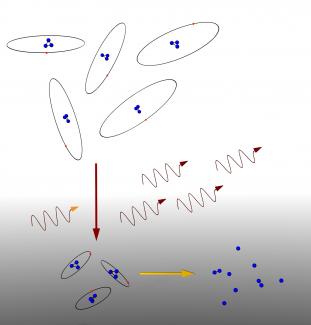Triatomic hydrogen ion (H3+) has many talents. In interstellar clouds, it can be blown apart by free low-energy free electrons, which interact with the ion core (H3+), briefly forming unstable H3 molecules. The interaction of the electron with the ion core almost immediately causes the molecule to fall apart into three hydrogen atoms (3H) or a hydrogen molecule (H2) and an H atom. This reaction is known as dissociative recombination (See JILA Light & Matter, Spring 2006).
Back on Earth, H3+ will collide with free electrons and helium or neon in the laboratory to eventually form the same products. However, the laboratory reaction occurs in a series of steps inside an ionized gas (plasma). The Earthbound pathway to dissociation includes excited H3 molecules lasing at infrared (IR) wavelengths to lose enough energy for the molecule to fall apart. Despite differing mechanisms, H3+ dissociation on Earth and in outer space does have one thing in common: The Greene theory group at JILA has explained them both.
Recently, graduate student Jia Wang and Fellow Chris Greene worked with experimentalists at the University of California, Berkeley, (1) to explain what is lasing inside the plasma and why, and (2) to elucidate a complex dissociation pathway involving interactions of H3+ ions, free electrons, H3 molecules, and helium atoms (He) inside a supersonically expanding plasma. In 2007, the experimentalists found the lasing spectrum in the lab and determined it could only be due to H3 molecules. Greene, who was on sabbatical at Berkeley at the time, and Wang calculated more than 20 different lasing line frequencies for the H3 molecule. Their theoretical frequencies corresponded reasonably well to the ones measured experimentally.
Since then, Greene and Wang have worked with the experimentalists at Berkeley to come up with an explanation of the behavior of the H3 molecules in the lab experiment: The researchers found thatH3 molecules are created in collisions of H3+ ions with free electrons in the plasma. But, unlike H3 molecules formed in space, these molecules don’t immediately fall apart. When an H3 molecule is formed inside a plasma in the laboratory, the captured electron can collide with a helium atom and gain angular momentum, which makes it harder for the electron to interact with the ion core.
Consequently, highly excited H3 molecules inside the plasma will cascade through states of decreasing energy by spontaneously losing energy. The H3 molecules eventually reach a quasi-stable state in which collisions with He no longer lower their energy, and they accumulate inside the plasma. Eventually, these H3 molecules will lase at infrared frequencies. The lasing process transfers the H3 molecules to a state in which their electrons are traveling slowly enough to interact with their ion cores. As soon as this interaction occurs, the molecule falls apart into either three H atoms or an H atom and an H2 molecule.
The elucidation of the mechanism underlying the H3 molecules’ flair for lasing was a coup for both the JILA theorists and the Berkeley experimentalists. Their article on this key accomplishment was selected as a 2010 “Editor’s Choice” by the Journal of Chemical Physics. - Julie Phillips



 The Physics Frontiers Centers (PFC) program supports university-based centers and institutes where the collective efforts of a larger group of individuals can enable transformational advances in the most promising research areas. The program is designed to foster major breakthroughs at the intellectual frontiers of physics by providing needed resources such as combinations of talents, skills, disciplines, and/or specialized infrastructure, not usually available to individual investigators or small groups, in an environment in which the collective efforts of the larger group can be shown to be seminal to promoting significant progress in the science and the education of students. PFCs also include creative, substantive activities aimed at enhancing education, broadening participation of traditionally underrepresented groups, and outreach to the scientific community and general public.
The Physics Frontiers Centers (PFC) program supports university-based centers and institutes where the collective efforts of a larger group of individuals can enable transformational advances in the most promising research areas. The program is designed to foster major breakthroughs at the intellectual frontiers of physics by providing needed resources such as combinations of talents, skills, disciplines, and/or specialized infrastructure, not usually available to individual investigators or small groups, in an environment in which the collective efforts of the larger group can be shown to be seminal to promoting significant progress in the science and the education of students. PFCs also include creative, substantive activities aimed at enhancing education, broadening participation of traditionally underrepresented groups, and outreach to the scientific community and general public.